Not long ago, the future did not look bright for Great Green Macaws. The global population of these magnificent parrots had dwindled to less than 1,000. Only a few dozen breeding pairs remained in Costa Rica. But today, Great Greens are making a comeback, and it’s largely due to the efforts of the Ara Manzanillo. In this post, we’ll share how this dedicated conservation group is making a difference and how you can visit their facility to see the magic for yourself.
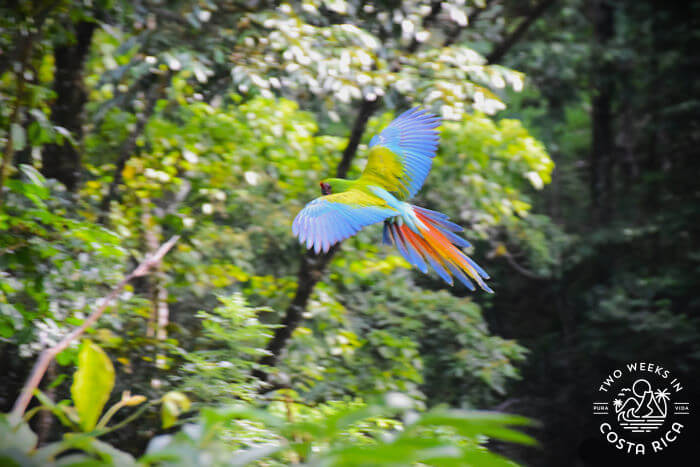
Background
We first visited the Ara Manzanillo project over ten years ago, but their efforts started even before that. Prior to formally becoming an established organization in 2010, a few conservationists concerned about Great Green Macaws were trying to help.
The population of these birds had been decimated because of the illegal pet trade and habitat loss. In the 1990s, with a handful of confiscated and rehabilitated Great Green Macaws, an idea was born: to take these birds, try to breed them, and release the babies back into the wild.
Ara Manzanillo Today
While the project is continuously evolving, the Ara Manzanillo organization has made great strides.
Over 100 Great Green Macaws from their facility now fly freely in the forest and along the beaches of Costa Rica’s southern Caribbean coast. That’s around 10% of the global population.
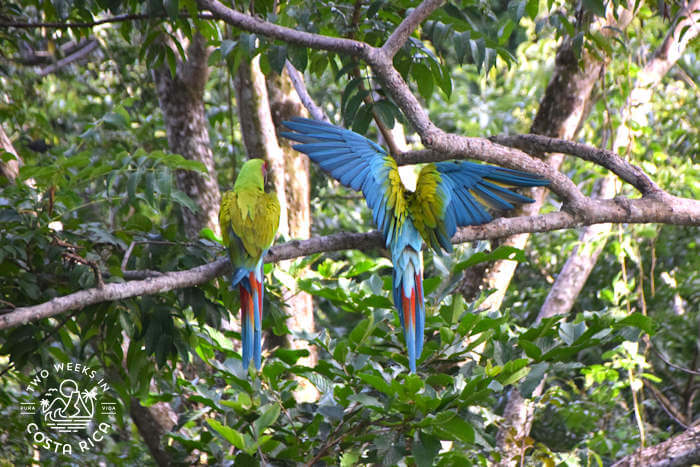
The Secrets to Success
Great Green Macaw Breeding Program
In the early days of the program, there weren’t many Great Green Macaws to reintroduce into the wild. But a partner program that we also had visited, called the Macaw Recovery Network (formerly the Ara Project), had a solution.
At a facility on Costa Rica’s Pacific coast, they bred mature pairs of Great Green Macaws and carefully raised the baby chicks. Once mature enough, these parrots were transported across the country to their new home in Manzanillo.
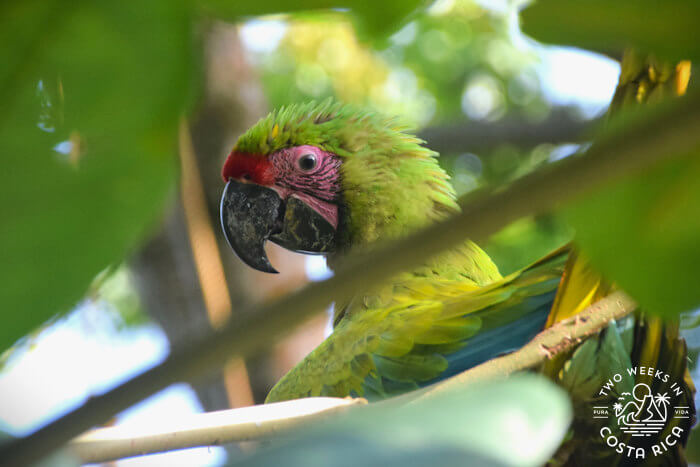
After teaching the birds to eat wild fruits like beach almonds, the young macaws were soft released into the wild. This meant that while they would be free to go, they also could come back each day for supplemental feeding, if they wanted.
In total, 45 Great Green Macaws were brought to Ara Manzanillo and released.
Habitat Restoration
An important part of the release program was to make sure the Great Green Macaws had enough natural habitat to survive.
The site in Manzanillo was chosen because it is centered between protected areas and national parks. These natural spaces have essential habitat and food for the birds. It was, in fact, their natural habitat in the past, before their numbers diminished.
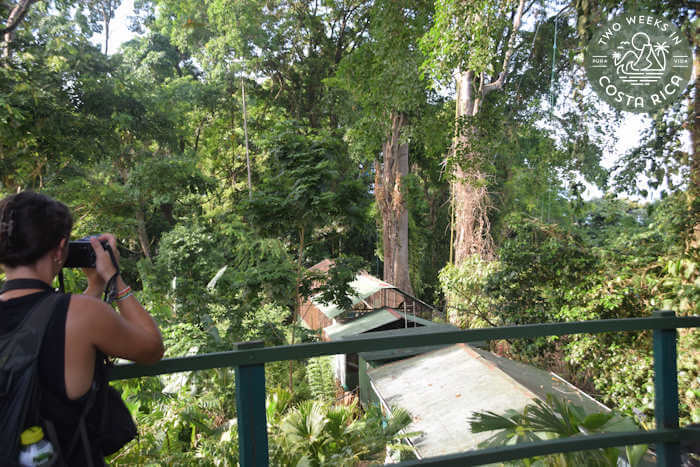
A key native species in the area is a tree called the mountain almond. The fruit of this tree is the favorite food of the green macaws, and it is also their most favorable tree for nesting. Ara Manzanillo has about 12 of these mature trees on their property.

The mountain almond tree is very rare in other parts of Costa Rica. It was harvested almost to extinction because of its desirable lumber. The durable wood is said to take decades to rot and is naturally insect resistant.
Part of Ara Manzanillo’s efforts go towards preserving and replanting this important tree for future generations of parrots.
Nesting Boxes
With a large number of Great Green Macaws from the original breeding program and a healthy forest surrounding the facility, the logical next step for the Ara Manzanillo project was to get these birds breeding by themselves in the wild.
Much like their soft release program with supplemental feeding, the birds just needed a little nudge in the right direction.
In 2016, Ara Manzanillo began to make special nesting boxes out of old plastic drums and wood. These were hung strategically near the facility in some of the mountain almond trees. After some trial and error, the boxes worked.
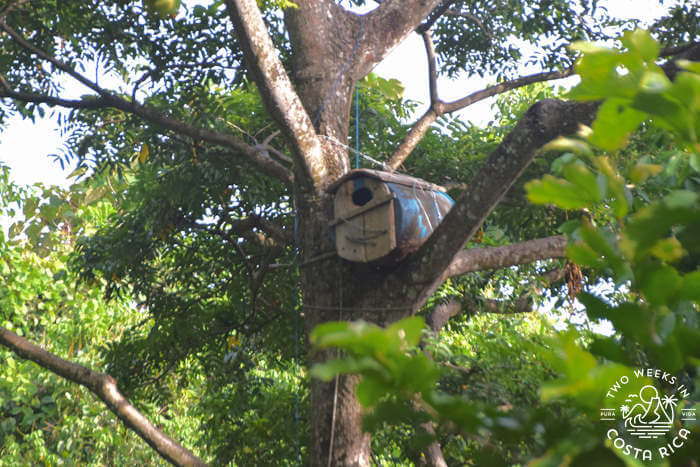
In the first year, a single chick successfully made it. The following year there were nine. Now with more nesting boxes, about 9-12 chicks per year hatch and join the flock.
It’s a slow process but as of 2023, more than 60 Great Green Macaw chicks have been born and fledged.
Education and Public Outreach
To keep this new population of Great Green Macaw’s safe, local support has been key. Ara Manzanillo staff does a lot of public outreach.
They are continuously teaching locals, especially at schools, about the impact of the illegal pet trade, poaching, and habitat loss.
Over the years, Ara Manzanillo has engrained themselves in the community and everyone knows who to call if a Green Macaw is found out of place or injured.
Visiting Ara Manzanillo
One amazing way to support the work of Ara Manzanillo is to visit them. Their 50-hectare (123-acre) property is located just south of Puerto Viejo on Costa Rica’s Caribbean coast.
Each afternoon, they allow visitors to come, learn about the project, and see the birds visit the supplemental feeders.
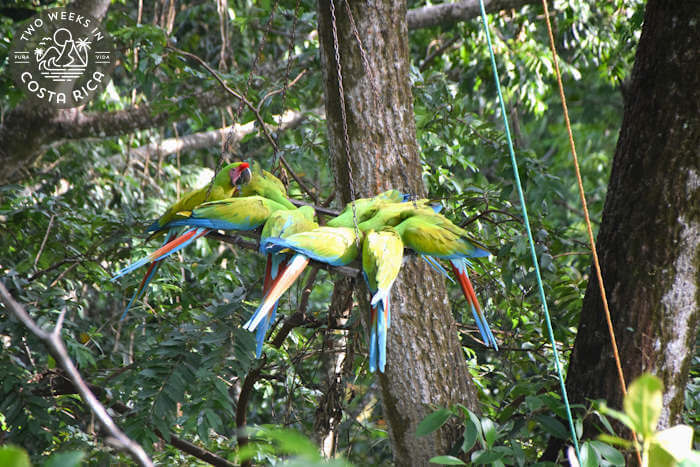
While some birds have moved away from the facility to start their own lives, Ara Manzanillo remains a gathering place for a large group of the original birds. During the tour, feeders filled with local seeds and fruits are raised into the trees.
From the viewing platform on the forested hill, streaks of green, blue, and red feathers go from tree to tree. Loud squawks ring out and wings flap. With so many birds in one place, you are guaranteed to get a good view or that perfect shot with your camera.
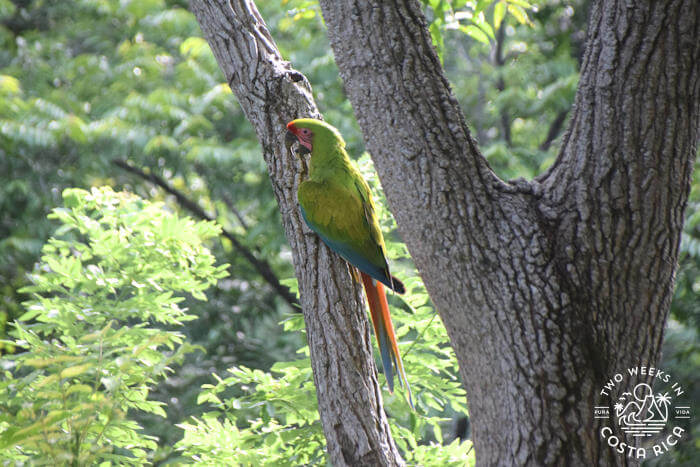
Reservations can be made through the Ara Manzanillo website. The cost is $20 per person. Children under 12 are free. The tour takes about one hour.
If you are unable to visit the project personally, you can follow their progress on social media channels and donate to their efforts.
Conclusion
Visiting the Ara Manzanillo project for the second time in a decade was a memorable and hopeful experience. It was great to see the healthy population of Great Green Macaws flourish and start using the nearby nesting boxes. And this time, we were able to share it with our kids who will hopefully see many more of these special birds in the wild.
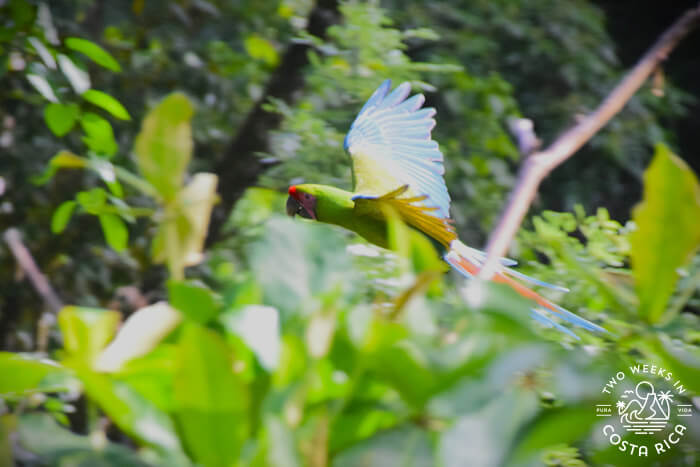
Have a question about visiting Ara Manzanillo? Leave a comment below.
Looking for more information to help you plan your trip? Check out these posts:
Puerto Viejo de Talamanca: Caribbean Cool in Costa Rica – Our destination guide for the area, including hotels, restaurants, and activities.
Choosing Sustainable Travel: Costa Rica’s Sustainable Tourism Program – Learn about this special rating system as well as what to look for when choosing accommodations and activities.
Costa Rica’s Caribbean Coast: Regional Snapshot – Explore what Costa Rica’s Caribbean coast has to offer and learn about the weather, landscape, and more.
